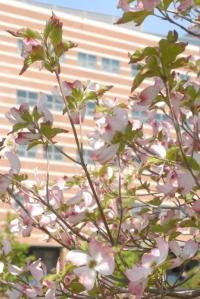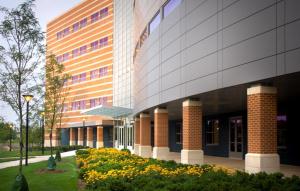The Universities at Shady Grove (USG) was among the recipients of the inaugural Bethesda Magazine Green Awards presented at the Bethesda Green Gala in 2010. We’re revisiting previous Green Champions, with a new cohort scheduled to be presented Thursday, Oct. 3, at the 2013 Gala (more info here or purchase tickets through Oct. 2 at this site).
The Camille Kendall Academic Center on the USG campus received LEED Gold certification in 2007. At the time it was the largest academic building in the state of Maryland to receive such an honor. This amazing achievement inspired a fresh perspective on environmental stewardship in the Shady Grove community.
“More sustainably and dynamically” seems to be the answer developing each day on campus. Jessica Nardi, Director of Administration, said that the USG administration began analyzing the way in which all aspects of the university — procurement, planning and housekeeping, for example — operated on a daily basis.
 No matter how large or small the operation — from waste management to the type of salt used during the winter season to melt ice — USG began making decisions by taking environmental impact into consideration. Some of their current green initiatives include campus wide recycling, energy and water conservation efforts, use of local produce, and environmental education. Jessica described their effort to serve the USG community as a “living laboratory,” an opportunity to experiment with and implement certain green efforts.
No matter how large or small the operation — from waste management to the type of salt used during the winter season to melt ice — USG began making decisions by taking environmental impact into consideration. Some of their current green initiatives include campus wide recycling, energy and water conservation efforts, use of local produce, and environmental education. Jessica described their effort to serve the USG community as a “living laboratory,” an opportunity to experiment with and implement certain green efforts.
An example of this can be seen in their work with Savenia Labs, an independent testing laboratory and information services company that provides energy and environmental impact ratings on popular appliances and electrical products and one of the Bethesda Green incubator companies. USG and Savenia Labs partnered to create a display to show members of the community the importance of also procuring small appliances with better energy ratings and sustainable life cycles.
All of this progress, however, would not be possible without the commitment and optimism of the student body. USG administration should be acknowledged for outlining and assembling the vehicle for effective action, but the students are indeed in the driver’s seat. Jessica characterized USG students as “dedicated and hardworking” individuals. So, she is never surprised to see their constant contributions (green-focused class gifts, carpooling, green tours, for example) to the sustainability mantra of USG. Likewise, it is inspiring to those of us outside the USG community to see both the holistic approach and shared responsibility evident on campus.
 USG is currently in a period of growth with a future that seems even brighter and greener. They have plans to construct a new parking garage in the next two years — a highly energy-efficient structure via a green construction process that’s also equipped with rainwater capture. Plans are also under way to construct a new Platinum LEED-certified 200,000 sq. ft. building in the next four years.
USG is currently in a period of growth with a future that seems even brighter and greener. They have plans to construct a new parking garage in the next two years — a highly energy-efficient structure via a green construction process that’s also equipped with rainwater capture. Plans are also under way to construct a new Platinum LEED-certified 200,000 sq. ft. building in the next four years.
USG has done something that is not always easy — they made a change. The Camille Kendall Academic Center marked a new standard of academic buildings on campus and ignited the other amazing efforts taking place today. Conveniently (and remarkably) enough, one action, one project, or one idea is all it takes to ignite change. We see what one building project did for USG. If we all decide to make that one change, the possibilities for a more sustainable future are endless.
A recent graduate of Denison University, Jon Akpapunam is an intern at both Clean Currents and the City Parks Alliance. He is passionate about both learning and developing new perspectives and strategies to create a more sustainable future.

Leave a comment